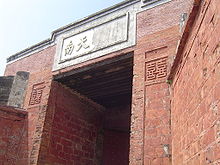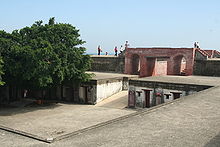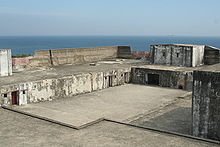- Cihou Fort
-
Qihou Fort or Qihou Battery (Chinese: 旗後砲臺; pinyin: qíhou pàotái) – 19th century fort, formerly guarding northern entrance to Kaohsiung harbour.
History
First fortifications were built in 1720, during Kangxi's reign.[1] After Japanese expedition in 1874 Chinese authorities constructed a modern fort, which in 1880 had new Armstrong's guns installed.[2] It played no part in Sino-French War; the fighting in Taiwan took place around Keelung and during blockade French ships did not approach the port.
Taiwan was ceased to Japan according to the Treaty of Shimonoseki in the aftermath of the first Sino-Japanese war. The local troops, however, fought on. On 12 October 1895, escadre commanded by admiral Arichi Shinanojo (cruisers Yoshino, Naniwa, Akitsushima, Yaeyama, Saien (ex Chinese Jiyuan, captured in Weihaiwei) and corvette Hiei) arrived at Kaohsiung and prompted the foreigners to evacuate, as they would conduct the attack on the next day. The foreigners boarded gunboat HMS Tweed and two tugs and withdrew (only to return once the fight was over). At 7 am, 13 October, Japanese ships opened fire on the forts, which returned the fire, but were silenced after half an hour. The forts fired 24 rounds altogether, the best of which landed ca 500 yards from Japanese cruisers. The Japanese troops seized the forts in early afternoon, suffering no casualties (4 Chinese soldiers were killed).[3]
During Japanese era the fort was not used.
After World War II the hill was fortified by Chinese army: light gun and machine gun nests cut in the rock can still be found there.
Construction
Planned by British engineer, H. W. Harwood,[1] the fort consists of three parts:
- fortified barracks, around rectangular square, with close-defence parapet on the roof. Of the two gates, one leads to the battery, the other used to be a main southern gate. It bore a Chinese inscription, which could be translated as "Mighty blow to the South" – the characters for "mighty blow" were shot away by a shell from Yoshino. The rest, still visible, serve as ironic remainder of history.
- central command post
The battery with two visible emplacements overlooking Taiwan Strait
- main rectangular battery with four open emplacements (two facing west, one north and one south) for four Armstrong's 7 inch rifled muzzle-loaders (RML 7-inch 6½-ton), with bunkers for crews. Magazines are located on the lower level. Steep slopes of the Qihou hill served as fort's natural scarps.
Of the 19th century fortification at the foot of the hill, only remainders are still visible.
References
- ^ a b Wetzel, Charles. "Cijin Island's Cihou Fort Guards Some Interesting History". http://korea.charles-wetzel.com/China_Site/cihou_fort/cihou_fort.htm. Retrieved 4 May 2010.
- ^ Davidson, James W. (1903). The Island of Formosa, Past and Present. London: Macmillian & Co. pp. 213.
- ^ J.W. Davidson, op.cit. pp. 357–8
Forts in Taiwan Cihou Fort · Eternal Golden Castle · Hobe Fort · Fort Provintia · Fort Santo Domingo · Uhrshawan Battery · Fort ZeelandiaCategories:
Wikimedia Foundation. 2010.




